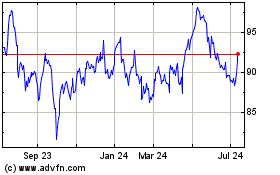Tropical Storm Isaias Knocks Out Power to 350,000 New Jersey Households
August 04 2020 - 2:06PM
Dow Jones News
By Akane Otani
Tropical Storm Isaias barreled through New York, New Jersey and
Connecticut on Tuesday, unleashing torrential rain and leaving
hundreds of thousands of residents without power.
The National Weather Service said Isaias was expected to deliver
up to 5 inches of rain in some parts of the region and possibly
lead to flooding. Weather forecasters and state officials also
warned of the potential for tornadoes to hit southeast New York,
northeast New Jersey and southern Connecticut.
As the storm picked up speed, it knocked out power across the
region. By midday Tuesday, around 350,000 households in New Jersey
were left in the dark, according to Jersey Central Power &
Light, which serves about 1.1 million customers in the state. About
11,000 customers in Staten Island and 5,000 households in Brooklyn
also lost power, according to electric utility Consolidated Edison
Inc.
Jersey Central Power & Light didn't say when it expected to
be able to restore power to affected households. ConEd said it
expected to be able to restore power in Staten Island by around
1:30 p.m. Tuesday and in Brooklyn by around 6 p.m.
New Jersey Gov. Phil Murphy declared a state of emergency late
Monday and urged state residents to stay off the roads and at
home.
"If you are out on our roads and come across a flooded section,
do not attempt to cross it. Turn around, don't drown," Mr. Murphy
said on Twitter.
New York City Mayor Bill de Blasio also warned residents to stay
at home.
"Between the rain, flooding potential, the winds and even a
potential tornado -- that's a lot," Mr. de Blasio said at a press
briefing on Tuesday. "Don't go outside if you don't need to during
the high point of the storm."
City workers spent Monday preparing for the storm, laying down
sand bags and "tiger dams" -- flood barriers filled with water --
around a mile-long stretch of lower Manhattan that experts believed
was particularly susceptible to flooding.
After making landfall in North Carolina late Monday as a
Category 1 hurricane, Isaias generated multiple tornadoes in the
state and in Virginia, causing at least one death and multiple
injuries. While the storm has since been downgraded to a tropical
storm, officials warned that residents in New York, New Jersey and
Connecticut should be on alert for potentially dangerous
conditions.
New York City officials prohibited swimming at beaches on
Tuesday, citing forecasts from the National Weather Service that
ocean swells could be as high as 10 feet.
"While surfing will still be allowed, lifeguards will not be on
duty, and we strongly urge all New Yorkers not to risk their lives
by ignoring this directive," Mitchell J. Silver, commissioner of
the city's Department of Parks & Recreation, said in a
statement.
Staff at city-owned marinas also checked on water pumps and
generators ahead of the storm. The facilities will have staff on
site 24/7 during the storm, said Nate Grove, chief of waterfront
and marine operations at the parks department.
Meanwhile, several tourist attractions and businesses announced
on social media and online that they were closed for the day,
including the Statue of Liberty National Monument and the 9/11
Memorial & Museum. The New York Yankees, which had been
scheduled to face off against the Philadelphia Phillies Tuesday
evening at Yankee Stadium, postponed their game as well.
Commuter service was also disrupted. New York City's ferry
service and the tram connecting Manhattan and Roosevelt Island were
suspended as of noon, while Metro-North Railroad urged customers to
finish their travels by early afternoon because it anticipated
weather-related delays.
Isaias is the second tropical storm to hit New York this summer.
If it sustains its speed of 70 mile-per-hour gusts, it would be the
strongest storm to hit New York since superstorm Sandy in 2012,
which destroyed thousands of homes and caused widespread power
outages.
Write to Akane Otani at akane.otani@wsj.com
(END) Dow Jones Newswires
August 04, 2020 13:51 ET (17:51 GMT)
Copyright (c) 2020 Dow Jones & Company, Inc.
Consolidated Edison (NYSE:ED)
Historical Stock Chart
From Mar 2024 to Apr 2024

Consolidated Edison (NYSE:ED)
Historical Stock Chart
From Apr 2023 to Apr 2024
